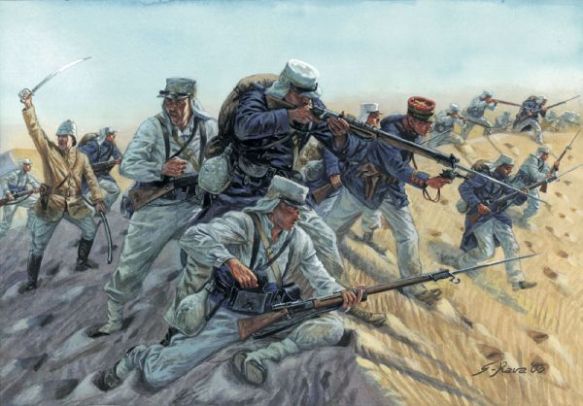Officially named the Régiment Étranger, the French Foreign Legion was the most storied and durable mercenary force attached to a regular army. France had a long history of employing foreign mercenaries before the creation of the legion; of 102 line regiments in the French army before the revolution, 23 were made up of foreign nationals. The French Foreign Legion was established in 1831 by Louis Philippe to mop up refugees coming into France after the Revolution of July 1830 made it illegal for foreigners to enlist in the French army. The Legion quickly became a home for foreign adventurers, social misfits, and every kind of criminal.
The Legion also became a military workhorse of French colonialism, seeing action for the first time in Algeria in 1832. In 1835–1836 the Legion served in the Carlist Wars in Spain, where it fought well yet was so decimated that it had to be rebuilt. Adopting the motto Legio patria nostra, “the Legion is our fatherland,” in the 1840s, it made its headquarters in Sidi-bel-Abbès in Algeria and played a major role in the French conquest of that country. Legion units also served in the Crimean War, the Austro-Piedmontese War, the Franco-Prussian War, and in French Indochina. Captain Jean Danjou, a highly decorated legionnaire who lost a hand in combat in Algeria in 1853, and had a wooden prosthetic made, died with most of his men in a last-ditch stand in the Battle of Camarón in Mexico in 1863. His wooden hand was recovered, is displayed at the legion headquarters in Aubagne in southern France, and is paraded annually on the anniversary of the battle.
Algeria
By the mid-nineteenth century, Algeria was a uniquely significant Northern African territory of the French Empire. After centuries as both the westernmost province of the Ottoman Empire and a base for the Barbary pirates, Algeria was invaded and colonized by the French in 1830 as part of Charles X’s efforts to preserve his throne after his attempts to restore autocratic royal power in France triggered widespread discontent. Although Charles lost his throne in the July Revolution of 1830, his successors opted to retain Algeria and spent the next several decades conquering the interior in the hopes of establishing a settlement colony that could also serve as a source of labor and food imports. The French presence was bitterly opposed by the Algerian forces under Abd-al-Qādir who quickly launched a fierce guerrilla war to drive out the invaders. France in turn retaliated by confiscating land, engaging in collective reprisals, and embracing a scorched earth policy of destroying crops and livestock. General Thomas-Robert Bugeaud, with the aid of over 100,000 French troops, eventually succeeded in conquering and pacifying the bulk of Algeria in 1847, but smaller French military operations continued in the interior zones until the early twentieth century.
As the army worked to pacify the interior, French settlers, also known as colons or pieds noirs, poured into Algeria’s urban and coastal areas in search of cheap land and business opportunities. Throughout the nineteenth century, the ranks of free settlers were also swelled by political prisoners deported after the Revolution of 1848 and the Paris Commune of 1870, as well as immigrants from Spain, Italy, and the nearby British colony of Malta. The size of the European settler community, which eventually reached 10 percent of the total Algerian population, meant that it exerted substantial political influence in Paris. The settlers enjoyed voting rights, owned most farms and businesses, and controlled the local administration, and the Algerian masses were rendered second-class citizens. In addition to facing chronic unemployment, poverty, and limited prospects for education, unless they abandoned their traditional culture and religion, Algerians were also denied voting rights and were subject to the indigénat, an arbitrary legal policy that allowed colonial administrators to impose summary fines and jail terms for a wide range of alleged offenses. The end result of these policies was lingering resentment that led to the rise of Algerian nationalism in the aftermath of the twentieth century’s two World Wars.
Morocco
One of the Barbary States of Northwest Africa, effectively independent since the Middle Ages but poor and territorially ill defined. Morocco supported the jihad of Adb el-Qadr against French dominion in Algeria, for which it suffered brutal retaliation in 1845. Morocco’s next clash with a European power came in 1859 in the form of invasion by Spain. Spain was not only geographically proximate to Morocco but also had been intermittently involved there going back to the fifteenth century. The invasion of 1859, however, was in response to Moroccan raids against outposts in northern Africa. A Spanish force captured the town of Tetuán in February 1860, and Morocco was forced to pay an indemnity and to cede more territory to Spain around the towns of Ceuta and Melilla. A second war followed in 1892. From 1863 onward, Morocco was of increasing interest to France. In 1904, an Anglo-French agreement gave France a free hand in Morocco in exchange for French acceptance of British supremacy in Egypt. Later the same year a secret agreement between France and Spain divided the country into spheres of influence. Thereafter, Morocco became the object of the Moroccan Crisis of 1905 and the Agadir Crisis of 1911, which brought Britain and France closer together and prefigured World War I.
FURTHER READING: Porch, Douglas. The French Foreign Legion. New York: Harper Collins, 1991; Turnbull, Patrick. The Foreign Legion. London: Heinemann, 1964. Ageron, Charles Robert. Modern Algeria: A History from 1830 to the Present. Trenton, NJ: Africa World Press, 1991; Bennoune, Mahfoud. The Making of Contemporary Algeria, 1830–1987: Colonial Upheavals and Post-independence Development. 2nd ed. Cambridge: Cambridge University Press, 2002; Stora, Benjamin. Algeria 1830–2000: A Short History. Ithaca, NY: Cornell University Press, 2001. Porch, Douglas. The Conquest of Morocco. New York: Knopf, 1982; Terrasse, Henri. History of Morocco. Translated by Hilary Tee. Casablanca: Éditions Atlantides, 1952.
